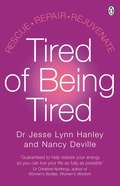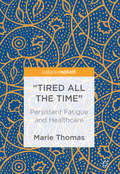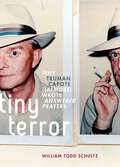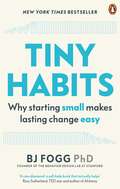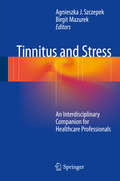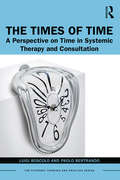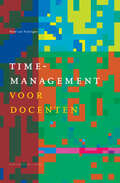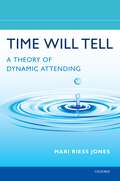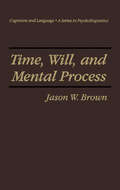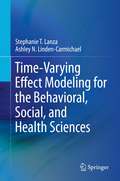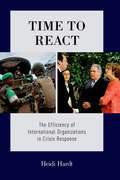- Table View
- List View
To Be Met as a Person at Work: The Effect of Early Attachment Experiences on Work Relationships
by Nicola Neath Una McCluskeyThis book provides an account of how the "Theory of Attachment-Based Exploratory Interest Sharing" (TABEIS) and the practise of Goal Corrected Empathic Attunement (GCEA) was used in a university setting to support staff. It works in three ways; firstly, it raises attachment theory, one of the pillars of self-understanding, into a central place in terms of reflecting on and learning from the dynamics of business and organisations. Neath explores how well this attachment theory sits with other theories of self and relationships such as transactional analysis and the person-centred approach.Secondly, it is an account of how Neath took an application of McCluskey's theory "The McCluskey Model for Exploring the Dynamics of Attachment in Adult Life" to the University of Leeds, with learning points made along the way, exploring the practise of a therapeutic-style of group facilitation, and reflection on good practice for professional adult learning and teaching techniques. Thirdly, it acts as a handbook for anyone wishing to replicate Neath's work and includes feedback from participants both during and after the training process. It will appeal to those new to training, counselling, organisational developers and those wishing to enjoy and see the potential of the work of McCluskey.
To Be Met as a Person: The Dynamics of Attachment in Professional Encounters
by Una McCluskeyThis book presents a theory of interaction in adult life when the dynamics of careseeking and caregiving are elicited. It sets out a framework for thinking about the way adults interact with one another, particularly when they are anxious, under stress or frightened.
To Be Met as a Person: The Dynamics of Attachment in Professional Encounters
by Una McCluskeyThis book presents a theory of interaction in adult life when the dynamics of careseeking and caregiving are elicited. It sets out a framework for thinking about the way adults interact with one another, particularly when they are anxious, under stress or frightened.
Tired of Being Tired: Rescue Repair Rejuvenate
by Dr Jesse Hanley'A good night's rest is the route to happiness' The GuardianTired of Being Tired is a breakthrough, step-by-step individualised programme for maximising health, vitality, wellbeing and longevity by the leading anti-ageing doctor, Dr Jesse Hanley. BENEFITS OF SLEEPPREVENT ILLNESSINCREASE YOUR ENERGY WITHOUT STIMULANTSACHIEVE A BALANCED WEIGHTSLOW DOWN AGEINGModern living ensures that many of us are so busy at work and at home, or even keeping up with our social engagements that we are not looking after ourselves. We seem to have little or no time to allow our bodies to rest, repair and rejuvenate and the results can be anything from chronic fatigue to weight gain, depression to constant colds - even life-threatening illnesses.However, it does not have to be this way. By taking the simple test and finding out which stage of tiredness you are in, you will discover exactly how you can get your energy back, lose weight, sleep soundly and much more by following this step-by-step program individually tailored to your own needs.
“Tired all the Time”: Persistent Fatigue and Healthcare
by Marie ThomasThis book explores the history, effects, diagnosis and treatment of chronic fatigue as well its significant links to other illnesses. Fatigue is a difficult symptom to accurately assess and quantify due to its subjective nature. Marie Thomas discusses the uncertainties and difficulties in its diagnosis as well as the broader effects of fatigue on quality of life. Fatigue is an increasingly reported problem in primary care, and one that is associated with other chronic conditions as a secondary symptom. Using several case studies, this book describes how in many cases, a patient’s primary condition can be managed; however General Practitioners are left unable to address the fatigue experienced, especially in older adults. Chapters consider the interventions that exist to manage fatigue – especially in the case of Chronic Fatigue Syndrome (CFS) – before highlighting the lack of strategies in primary care for dealing with the problem. In the final chapter Thomas discusses potential interventions and gives recommendations for future research regarding fatigue. This book will be of interest to academics and practitioners in healthcare and psychology, as well as to patient groups and those who care for individuals with fatigue.
“Tired all the Time”: Persistent Fatigue and Healthcare
by Marie ThomasThis book explores the history, effects, diagnosis and treatment of chronic fatigue as well its significant links to other illnesses. Fatigue is a difficult symptom to accurately assess and quantify due to its subjective nature. Marie Thomas discusses the uncertainties and difficulties in its diagnosis as well as the broader effects of fatigue on quality of life. Fatigue is an increasingly reported problem in primary care, and one that is associated with other chronic conditions as a secondary symptom. Using several case studies, this book describes how in many cases, a patient’s primary condition can be managed; however General Practitioners are left unable to address the fatigue experienced, especially in older adults. Chapters consider the interventions that exist to manage fatigue – especially in the case of Chronic Fatigue Syndrome (CFS) – before highlighting the lack of strategies in primary care for dealing with the problem. In the final chapter Thomas discusses potential interventions and gives recommendations for future research regarding fatigue. This book will be of interest to academics and practitioners in healthcare and psychology, as well as to patient groups and those who care for individuals with fatigue.
Tips from Widows
by Jan Robinson'This is a wonderful, beautiful little book. It is like a quiet, wise friend, full of comfort and practical counsel, when your world has collapsed or changed beyond recognition. It is like a crib sheet of how to cope; it is as helpful to friends of widows as to the widows themselves, and it is written from experience, which is the bedrock of reliable advice' Joanna Lumley When Jan Robinson's husband died suddenly and unexpectedly, she had the idea of asking any other widows, whenever and wherever she met them, for two tips about how to deal with widowhood – anything that came to mind, whether it was what to do or what not to do, however seemingly unimportant. That is how Tips from Widows started. Grief is an unmanageable emotion and the form it takes is unique to every woman whose husband or partner has died. There are no set rules about coping with loss. Some people struggle with it for years and maybe never get over it. Others manage to move on. This book makes no claim to be an authority on how to cope as a widow, nor does it set out to offer a thorough analysis of widowhood. It is, quite simply, tips from widows. You may be alone in your boat on the ocean, but Tips from Widows will help you to recognise that other boats are out there too.
Tips from Widowers
by Jan RobinsonWith foreword by journalist Robert PestonWhen Jan Robinson's husband died suddenly and unexpectedly, she had the idea of asking any other widows, whenever and wherever she met them, for two tips about how to deal with widowhood. From this advice, she constructed her beautiful first volume, Tips from Widows. To Robinson's surprise, the book generated an overwhelming response not only from widows, but also from widowers. From these outpourings it became evident that a second book, this time for widowers, was inevitable. Grief is an unmanageable emotion and the form it takes is unique to every man whose wife or partner has died. There are no set rules about coping with loss. Some people struggle with it for years and maybe never get over it. Others manage to move on. This book makes no claim to be an authority on how to cope as a widower; it is, quite simply, tips from widowers. You may be alone in your boat on the ocean, but Tips from Widowers will help you to recognise that other boats are out there too.
Tiny Terror: Why Truman Capote (Almost) Wrote Answered Prayers (Inner Lives)
by William Todd SchultzTruman Capote was one of the most gifted and flamboyant writers of his generation, renowned for such books as Other Voices, Other Rooms, Breakfast at Tiffany's, and his masterpiece, the nonfiction novel In Cold Blood. What has received comparatively little attention, however, is Capote's last, unfinished book, Answered Prayers, a merciless skewering of cafe society and the high-class women Capote called his "swans." When excerpts appeared he was immediately blacklisted, ruined socially, labeled a pariah. Capote recoiled--disgraced, depressed, and all but friendless. In Tiny Terror, a new volume in Oxford's Inner Lives series, William Todd Schultz sheds light on the life and works of Capote and answers the perplexing mystery--why did Capote write a book that would destroy him? Drawing on an arsenal of psychological techniques, Schultz illuminates Capote's early years in the South--a time that Capote himself described as a "snake's nest of No's"--no parents to speak of, no friends but books, no hope, no future. Out of this dark childhood emerged Capote's prominent dual life-scripts: neurotic Capote, anxious, vulnerable, hypersensitive, expecting to be hurt; and Capote the disagreeable destroyer, emotionally bulletproof, nasty, and bent on revenge. Schultz shows how Capote would strike out when he felt hurt or taken for granted, engaging in caustic feuds with Gore Vidal, Tennessee Williams, and many other writers. And Schultz reveals how this tendency fed into Answered Prayers, an exceedingly corrosive and thinly disguised roman a clef that trashed his high-society friends. What emerges by the end of this book is a cogent, immensely insightful portrait of an artist on the edge, brilliantly but self-destructively biting the jet-set hands that fed him. Anyone interested in the inner life of one of America's most fascinating literary personalities will find this book a revelation.
Tiny Terror: Why Truman Capote (Almost) Wrote Answered Prayers (Inner Lives)
by William Todd SchultzTruman Capote was one of the most gifted and flamboyant writers of his generation, renowned for such books as Other Voices, Other Rooms, Breakfast at Tiffany's, and his masterpiece, the nonfiction novel In Cold Blood. What has received comparatively little attention, however, is Capote's last, unfinished book, Answered Prayers, a merciless skewering of cafe society and the high-class women Capote called his "swans." When excerpts appeared he was immediately blacklisted, ruined socially, labeled a pariah. Capote recoiled--disgraced, depressed, and all but friendless. In Tiny Terror, a new volume in Oxford's Inner Lives series, William Todd Schultz sheds light on the life and works of Capote and answers the perplexing mystery--why did Capote write a book that would destroy him? Drawing on an arsenal of psychological techniques, Schultz illuminates Capote's early years in the South--a time that Capote himself described as a "snake's nest of No's"--no parents to speak of, no friends but books, no hope, no future. Out of this dark childhood emerged Capote's prominent dual life-scripts: neurotic Capote, anxious, vulnerable, hypersensitive, expecting to be hurt; and Capote the disagreeable destroyer, emotionally bulletproof, nasty, and bent on revenge. Schultz shows how Capote would strike out when he felt hurt or taken for granted, engaging in caustic feuds with Gore Vidal, Tennessee Williams, and many other writers. And Schultz reveals how this tendency fed into Answered Prayers, an exceedingly corrosive and thinly disguised roman a clef that trashed his high-society friends. What emerges by the end of this book is a cogent, immensely insightful portrait of an artist on the edge, brilliantly but self-destructively biting the jet-set hands that fed him. Anyone interested in the inner life of one of America's most fascinating literary personalities will find this book a revelation.
A Tiny Spark of Hope: Healing Childhood Trauma in Adulthood
by Kim Golding Alexia JonesI could not ignore the tiny spark of hope that whispered to me that there might be someone with whom I could be vulnerable and real, and that this time they might just not let me down...This is the story of Alexia and her therapist Kim, and their three-year therapy journey to begin Alexia's path to recovery. Written from both perspectives, it is a powerful and revealing account of a therapist-client relationship. Together, the authors show the manifold challenges that adult survivors of childhood abuse have to overcome, and offer insight to all therapists on how relational interventions can pave a way to healing.
A Tiny Spark of Hope: Healing Childhood Trauma in Adulthood
by Kim Golding Alexia JonesI could not ignore the tiny spark of hope that whispered to me that there might be someone with whom I could be vulnerable and real, and that this time they might just not let me down...This is the story of Alexia and her therapist Kim, and their three-year therapy journey to begin Alexia's path to recovery. Written from both perspectives, it is a powerful and revealing account of a therapist-client relationship. Together, the authors show the manifold challenges that adult survivors of childhood abuse have to overcome, and offer insight to all therapists on how relational interventions can pave a way to healing.
Tiny Habits: The Small Changes That Change Everything
by BJ FoggImproving your life is much easier than you think. Whether it’s losing weight, sleeping more, or restoring your work/life balance – the secret is to start small.For years, we’ve been told that being more healthy and productive is a matter of willpower: that we should follow the latest fad and make constant changes to our lifestyles. But whether in our diets, fitness plans or jobs, radical overhauls never work. Instead we should start with quick wins — and embed new, tiny habits into our everyday routines.The world expert on this is Silicon Valley legend BJ Fogg, pioneering research psychologist and founder of the iconic Behaviour Design Lab at Stanford. Now anyone can use his science-based approach to make changes that are simple to achieve and sticky enough to last.In the hugely anticipated Tiny Habits, BJ Fogg shows us how to change our lives for the better, one tiny habit at a time. Based on twenty years research and his experience coaching over 40,000 people, it cracks the code of habit formation. Focus on what is easy to change, not what is hard; focus on what you want to do, not what you should do. At the heart of this is a startling truth — that creating happier, healthier lives can be easy, and surprisingly fun.
TINY FEET: A Treasury for Parents
by Lauren Child‘It was the most liberating thing that ever happened to me, having children. The children’s demands on me were things that nobody else ever asked me to do.’ Toni Morrison Children are a wonder – a miracle – and everyone has an opinion on how we should raise them. From novelists to paediatricians; from modern parenting ‘experts’ to child psychologists, Tiny Feet is the first anthology of its kind, showcasing a range of the most influential writing about children over the past four-hundred years. Published chronologically, the extracts featured in this delightful compendium show the extent to which some of our attitudes have changed while others remain absolute, and remind us of the joy that children have always brought to our lives. Contributors include: Erik H. Erikson on the meaning of play; Marvin J. Gersh on how to raise children in your ‘spare time’; Naomi Stadlen on how parenting books undermine parenting by reducing it to a number of essential tasks; Donald Winnicott on ‘the good-enough mother’. Plus: memoir, fiction and further opinion from Daniel Burgess, Jean-Jacques Rousseau, Johann Heinrich Pestalozzi, Isabella Beeton, Charles Darwin, Robert Louis Stevenson, James Sully, Maria Montessori, Bertrand Russell, Margaret Mead, Jean Piaget, Harry F. Harlow, Dr. Spock, Marvin J. Gersh, Toni Morrison, Lydia Davis, Toni Morrison, Alison Gopnik, Giuseppina Persico, Cleon C. Mason, Bernardine Evaristo, Ella Cara Deloria, John B. Watson and Rosalie Rayner.
Tinnitus and Stress: An Interdisciplinary Companion for Healthcare Professionals
by Agnieszka Szczepek Birgit MazurekThis book provides up-to-date scientific information on the pathways by which psychosocial stress can affect the auditory system and describes current approaches to the management of patients with stress-related tinnitus. The latest evidence is presented on aspects such as the role of stress hormones in auditory function, the effects of allostatic load, circadian sensitivity to auditory trauma, and the association between stress-related biomarkers and tinnitus. The clinically oriented chapters discuss psychometric instruments of value in the tinnitus clinic and present stress-related tinnitus treatment protocols and outcome measures. It is widely acknowledged that the tinnitus percept acts as a stressor. However, it is also now evident that psychosocial stress can play a causative role in tinnitus and that the impact varies according to the level, duration, and quality of the stress. Assessment of the types and levels of stress in tinnitus patients before, during, and after treatment is therefore very important. Healthcare professionals attending tinnitus patients will benefit from the information that this book provides on the relationship between tinnitus and stress and from the practical guidance that it offers.
The Times of Time: A Perspective on Time in Systemic Therapy and Consultation (The Systemic Thinking and Practice Series)
by Luigi Boscolo Paolo BertrandoThis is the most comprehensive study of the role of time in psychotherapy. It illustrates how time is experienced in different ways – individual time, family time, and social time – and how time can act as an invaluable metaphor in shaping clinical practice within a systemic approach, while maintaining connections with other approaches, such as psychoanalysis and cognitive therapies. A seminal volume on this topic, the book looks at issues such as the duration of therapy; the relevance of past, present, and future in therapy; and the balance of memory and oblivion. It also includes a discussion of how time is framed in other disciplines, including sociology, history, and psychopathology, whilst exploring the concept in practical terms through case vignettes and complete case histories, including the transcripts of actual sessions. The reader is thus given a set of guidelines for dealing with time issues in therapy from a systemic perspective. Originally published in 1993, the book has been updated to create a dialogue with contemporary theoretical debates, as well as social and technological changes. It will fascinate all psychotherapists, particularly those interested in a systemic practice.
The Times of Time: A Perspective on Time in Systemic Therapy and Consultation (The Systemic Thinking and Practice Series)
by Luigi Boscolo Paolo BertrandoThis is the most comprehensive study of the role of time in psychotherapy. It illustrates how time is experienced in different ways – individual time, family time, and social time – and how time can act as an invaluable metaphor in shaping clinical practice within a systemic approach, while maintaining connections with other approaches, such as psychoanalysis and cognitive therapies. A seminal volume on this topic, the book looks at issues such as the duration of therapy; the relevance of past, present, and future in therapy; and the balance of memory and oblivion. It also includes a discussion of how time is framed in other disciplines, including sociology, history, and psychopathology, whilst exploring the concept in practical terms through case vignettes and complete case histories, including the transcripts of actual sessions. The reader is thus given a set of guidelines for dealing with time issues in therapy from a systemic perspective. Originally published in 1993, the book has been updated to create a dialogue with contemporary theoretical debates, as well as social and technological changes. It will fascinate all psychotherapists, particularly those interested in a systemic practice.
Timemanagement voor docenten (Docentenreeks)
by R. van KralingenIedere docent heeft regelmatig met piekbelasting in zijn onderwijspraktijk te maken. Ook structurele overbelasting komt in het onderwijs voor. Dit boek helpt docenten werkdruk in beeld te brengen en de oorzaken van werkdruk te achterhalen. Docenten worden in dit boek individueel en op teamniveau in staat gesteld werkdruk te lijf te gaan door hun kernactiviteiten te analyseren. Er worden allerlei tips en tools gegeven om tot efficiënte onderwijssessies, coachings– en begeleidingsessies, toetsen en beoordelingen, vernieuwingsoperaties en vergaderingen te komen. Er worden suggesties gegeven om werkdruk op korte én lange termijn te verminderen. Het ervaren van werkdruk blijft een persoonlijke zaak. Om tot zelfanalyse en vergelijking met collega's te komen, worden er verschillende instrumenten aangeboden.
Time Will Tell: A Theory of Dynamic Attending
by Mari Riess JonesAttention is a central concept in psychology. The term 'attention' itself has persisted, even though it implies a static, insulated capacity that we use when it is necessary to focus upon some relevant or stimulating event. Riess Jones presents a different way of thinking about attention; one that describes it as a continuous activity that is based on energy fluctuating in time. A majority of attention research fails to examine influence of event time structure (i.e., a speech utterance) on listeners' moment-to-moment attending. General research ignores listeners endowed with innate, as well as acquired, temporal biases. Here, attending is portrayed as a dynamic interaction of an individual within his or her surroundings. Importantly, this interaction involves synchronicity between an attender and external events. This emphasis on time and synchronicity distinguishes the author's theory, called Dynamic Attending Theory (DAT), from other approaches to attending which characterize attention metaphorically as a filter, resource pool, spotlight, and so on. Recent research from neuroscience has lent support to Riess Jones' theory, and the goal of this book is to bring this new research as well as her own to the wide audience of psychologists interested in attention more broadly.
Time Will Tell: A Theory of Dynamic Attending
by Mari Riess JonesAttention is a central concept in psychology. The term 'attention' itself has persisted, even though it implies a static, insulated capacity that we use when it is necessary to focus upon some relevant or stimulating event. Riess Jones presents a different way of thinking about attention; one that describes it as a continuous activity that is based on energy fluctuating in time. A majority of attention research fails to examine influence of event time structure (i.e., a speech utterance) on listeners' moment-to-moment attending. General research ignores listeners endowed with innate, as well as acquired, temporal biases. Here, attending is portrayed as a dynamic interaction of an individual within his or her surroundings. Importantly, this interaction involves synchronicity between an attender and external events. This emphasis on time and synchronicity distinguishes the author's theory, called Dynamic Attending Theory (DAT), from other approaches to attending which characterize attention metaphorically as a filter, resource pool, spotlight, and so on. Recent research from neuroscience has lent support to Riess Jones' theory, and the goal of this book is to bring this new research as well as her own to the wide audience of psychologists interested in attention more broadly.
Time, Will, and Mental Process (Cognition and Language: A Series in Psycholinguistics)
by Jason W. BrownIn this volume, distinguished neurologist Jason W. Brown extends the microgenetic theory of the mind by offering a new approach to the problem of time and free will. Brown bases his work on a unitary process model of brain and behavior. He examines the problem of subjective time and free will, the experiential present, the nature of intentionality, and the creative properties of physical growth and mental process.
Time Warped: Unlocking the Mysteries of Time Perception
by Claudia HammondTime rules our lives, but how much do we really understand it? In Time Warped, we meet the people willing to go to extreme lengths to find out. They travel to Costa Rica to find out if hummingbirds can sense the passage of time, they walk towards the edge of a stairwell blindfolded and one man spends two months in an ice cave in total darkness - all in an attempt to fathom the tricks time can play on our minds. Drawing on the latest research from psychology, neuroscience and biology, award-winning BBC Radio4 presenter Claudia Hammond delves into the mysteries of time perception. She shows us how to manage time more efficiently, why speeds up as you get older and, ultimately, how to use the warping of time to our own advantage.
Time-Varying Effect Modeling for the Behavioral, Social, and Health Sciences
by Stephanie T. Lanza Ashley N. Linden-CarmichaelThis book is the first to introduce applied behavioral, social, and health sciences researchers to a new analytic method, the time-varying effect model (TVEM). It details how TVEM may be used to advance research on developmental and dynamic processes by examining how associations between variables change across time. The book describes how TVEM is a direct and intuitive extension of standard linear regression; whereas standard linear regression coefficients are static estimates that do not change with time, TVEM coefficients are allowed to change as continuous functions of real time, including developmental age, historical time, time of day, days since an event, and so forth.The book introduces readers to new research questions that can be addressed by applying TVEM in their research. Readers gain the practical skills necessary for specifying a wide variety of time-varying effect models, including those with continuous, binary, and count outcomes. The book presents technical details of TVEM estimation and three novel empirical studies focused on developmental questions using TVEM to estimate age-varying effects, historical shifts in behavior and attitudes, and real-time changes across days relative to an event. The volume provides a walkthrough of the process for conducting each of these studies, presenting decisions that were made, and offering sufficient detail so that readers may embark on similar studies in their own research. The book concludes with comments about additional uses of TVEM in applied research as well as software considerations and future directions. Throughout the book, proper interpretation of the output provided by TVEM is emphasized.Time-Varying Effect Modeling for the Behavioral, Social, and Health Sciences is an essential resource for researchers, clinicians/practitioners as well as graduate students in developmental psychology, public health, statistics and methodology for the social, behavioral, developmental, and public health sciences.
Time to Listen to Children: Personal and Professional Communication
by Birgit Carolin Pat MilnerTime to Listen to Children is a practical guide to effective communication with children. Professionals working with children in a variety of settings examine the skills required to help children articulate their problems and feelings. They discuss issues such as training, cultural background and religion and give accounts of their work in the following settings: * education * social services * voluntary organizations * medical settings * law Contributors practice a variety of therapeutic techniques, including play, music and art therapy. Time to Listen to Children will be a valuable resource for social workers, teachers and counsellors in training and for all professionals who wish to adopt a skilled, reflective and active approach to their work with children.


